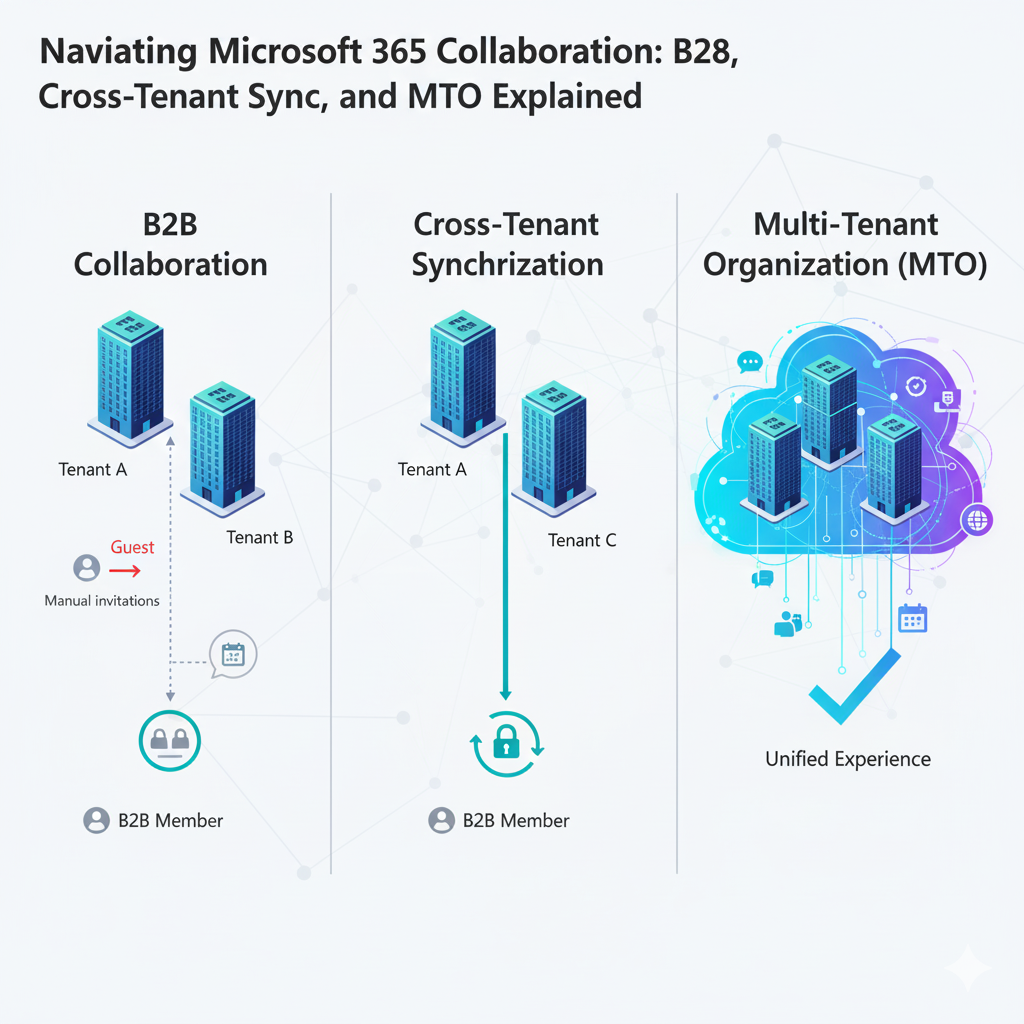In today’s interconnected business world, collaborating across organizational boundaries is no longer a luxury, but a necessity. Microsoft 365 offers a robust suite of tools for this, but the terminology can sometimes be a bit of a maze. If you’ve ever wondered about the difference between B2B Collaboration, Cross-Tenant Synchronization, and Multi-Tenant Organization (MTO), you’re not alone!
Let’s break down these three key concepts in Microsoft Entra ID (formerly Azure AD), clarifying their purpose, benefits, and when to use each.
1. B2B Collaboration: The Guest Invitation (Ad-hoc & Flexible)
Think of it like: Inviting a guest to your house for a party.
B2B Collaboration is the foundational capability that allows you to invite external users (guests) from any organization to access specific resources in your Microsoft Entra ID tenant.
- How it works: You send an invitation to an external user’s email address. They click a link, accept the invitation, and then gain access to the resources you’ve shared (e.g., a SharePoint site, a Teams channel, an application).
- User Type: These users are typically provisioned as Guest accounts in your tenant, often identifiable by the
#EXT#in their User Principal Name (e.g.,user_external.com#EXT#@yourtenant.onmicrosoft.com). - Key Characteristics:
- Manual: Requires an invitation and a redemption process.
- Resource-Specific: Guests only get access to what you explicitly share with them.
- Versatile: Works for any external partner, vendor, or customer.
- Tenant Switching: Guests often need to manually switch tenants in Teams to access the shared resources or participate in chats from the inviting organization.
- Best for: Project-based collaboration with external vendors, partners, consultants, or customers where granular, time-limited access is sufficient.
2. Cross-Tenant Synchronization: Automating the Guest/Member Lifecycle (Affiliated Tenants)
Think of it like: An automated HR feed between two very closely affiliated business units, ensuring everyone appears in the right directory.
Cross-Tenant Synchronization (often referred to as B2B Sync) takes B2B Collaboration to the next level by automating the provisioning and lifecycle management of user identities between two specific Entra ID tenants. It’s designed for scenarios where two organizations (often sister companies or subsidiaries) have a close, ongoing relationship.
- How it works: Instead of manual invitations, administrators configure a synchronization job. This job automatically creates, updates, and deletes user objects in the target tenant based on changes in the source tenant.
- User Type: Crucially, users provisioned via Cross-Tenant Synchronization can be created as B2B Members in the target tenant, not just Guests. This is a significant distinction that grants them a more “internal-like” experience and better access to resources that might typically restrict Guest accounts.
- Key Characteristics:
- Automated: No manual invitations or redemption required.
- Lifecycle Management: Identities are kept in sync, including updates and de-provisioning.
- GAL Visibility: B2B Members can seamlessly appear in the target tenant’s Global Address List (GAL).
- Improved Access: Member status allows for broader access to applications and services.
- Still distinct: While better, the Teams experience might still involve some degree of tenant switching or context management, though this has improved significantly.
- Best for: Closely related organizations (e.g., parent company and subsidiary, sister companies after an acquisition) that need synchronized user directories and persistent, managed identity sharing.
3. Multi-Tenant Organization (MTO): The “One Org” Experience (Owned Tenants)
Think of it like: A single corporate entity with multiple office locations, but everyone feels like they’re part of one company, regardless of which building they’re in.
Multi-Tenant Organization (MTO) is Microsoft’s most comprehensive solution for organizations that own or tightly control multiple Microsoft 365 tenants. It’s built on top of Cross-Tenant Synchronization and adds an additional layer of integration and a vastly improved end-user experience, particularly for Microsoft Teams.
- How it works: You explicitly define a group of tenants as belonging to the same MTO in the Microsoft 365 Admin Center. This setup then leverages Cross-Tenant Synchronization to provision users as B2B Members across the participating tenants and enables MTO-specific features.
- User Type: Relies on users being provisioned as B2B Members via Cross-Tenant Sync.
- Key Characteristics:
- Seamless Teams: Users can receive real-time notifications, participate in chats, and see presence for colleagues in other MTO tenants without manually switching tenants in the New Teams client.
- Shared Resources: Enables features like synchronized Free/Busy calendar availability and a unified GAL across all MTO tenants.
- Simplified App Access: Identity trust allows for more seamless access to applications hosted in other MTO tenants.
- Centralized Management: Provides a framework for consistent policy application and easier administration across the linked tenants.
- Best for: Large organizations, conglomerates, or institutions that have intentionally spun up multiple Microsoft 365 tenants (e.g., due to mergers, divestitures, or geographical needs) and want to provide a truly unified, “single organization” collaboration experience for their employees.
Which one should you use?
The choice depends on your relationship with the external entity:
- External Partners/Vendors (Ad-hoc): B2B Collaboration (Guest accounts).
- Closely Affiliated Companies (Managed Identities): Cross-Tenant Synchronization (B2B Members).
- Multiple Tenants within the Same Organization (Unified Experience): Multi-Tenant Organization (MTO) (leveraging B2B Members via Cross-Tenant Sync).
By understanding these distinctions, you can implement the right collaboration strategy to empower your users while maintaining security and control across your Microsoft 365 environment.



